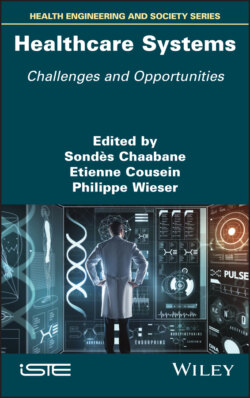Читать книгу Healthcare Systems - Группа авторов - Страница 12
Оглавление
Summary of Contributions – Part 1
Towards a Prototype for the Strategic Recomputing of Schedules in Home Care Services, by Cléa MARTINEZ, Maria DI MASCOLO, Marie-Laure ESPINOUSE and Jérôme RADUREAU.
Home care is an alternative to traditional hospitalization to cope with aging populations and the increase in the number of vulnerable people whilst ensuring a good quality of life for patients. Even though these structures are developing more and more, the planning of their activities remains manual and can be time-consuming and exceedingly complex on a large scale. It is therefore essential to have effective solutions for planning interventions with an update mechanism to compensate for unforeseen events. This contribution therefore offers a decision support tool to solve the problem of long-term re-scheduling in the home care sector. A weekly planning update prototype was developed to meet a need expressed by a home care company operating in Auvergne Rhône-Alpes: Adomni-Quemera.
Home Healthcare Scheduling Activities, by Rym BEN BACHOUCH JACQUIN and Jihene TOUNSI.
This chapter examines the problem of planning rounds in hospitalization at home (HaH) by taking into account uncertainties and integrating dynamic re-scheduling. The authors propose an approach based on a genetic algorithm which considers re-scheduling in real time to resolve any conflicts that may arise as a result of unforeseen disruptions which may occur. This approach takes place in two phases. The first phase is carried out “offline”, making it possible to establish the schedules of the nursing staff. The second phase is “online”, making it possible to manage unforeseen events in real time, such as the absence of staff and delays in care. In the disrupted context, a new schedule is generated in order to cope with the disruption. The results obtained show the efficiency and robustness of the proposed approach with rapid computation time.
Optimal Sizing of an Automated Dispensing Cabinet under Adjacency Constraints, by Khalid HACHEMI, Didier GOURC and François MARMIER.
This contribution focuses on the dispensing phase of the medication circuit. This phase corresponds to the validation of the prescription, preparation and delivery of the medication. The main objective of the study is to minimize the errors that occur during this phase and, more specifically, in the case of automated dispensation cabinets. Such errors can occur when the cabinet is filled with the wrong product in the wrong place resulting in the wrong medication being delivered to the patient. To resolve this problem, the authors propose an algebraic model for the calculation of boundary conditions necessary for the allocation of medications to different compartments of a cabinet. This method must ensure that certain products are not placed in neighboring compartments due to the risk of confusion, which may lead to distribution errors, for example, medicinal products having a similar appearance, nomenclature or dosage. A modeling of the maximum permissive target problem (MPTP) has been proposed, as well as its resolution through a real-world digital application.
Validation of an Automated and Targeted Pharmaceutical Analysis Tool at the CHU de Liège, by Sophie STREEL, Nathalie MAES, Véronique GONCETTE, Laurence SEIDEL, Denis MENAGER, Adelin ALBERT, Philippe KOLH and Didier MAESEN.
This next contribution also looks at the medication flow, which can be a major challenge for a hospital. This flow is a complex and multidisciplinary process, which includes the clinical pathways (prescription, distribution, administration) and logistics (supply, transport, storage). The computerization of the medication flow at the “CHU de Liège” is widely implemented. This study describes how an automated and targeted pharmaceutical analysis tool was built, implemented and evaluated at the “CHU de Liège”. The objective of this tool is to provide reliable and solid support to pharmacists for the verification of prescriptions so as to optimize and meet the hospital’s accreditation criteria. Various pharmaceutical validation algorithms were thus constructed, and the computer validation tool was developed and tested on these bases which generated very encouraging results.
Simulation of Countermeasures in the Face of Covid-19 Using a Linear Compartmental Model, by Alain GUINET.
Since the start of 2020, the whole world has been confronted by a pandemic, which led to the confinement of over half of the world’s inhabitants. We are disarmed in the face of the coronavirus (SARS-CoV-2), and containment seems to be the only countermeasure capable of containing the pandemic despite the consequential economic cost. This chapter presents a simulation of the epidemic based on the SIR (Susceptible–Infected–Recovered) model, which is known as a compartmental model in epidemiology. This simulation makes it possible to calculate, by period, the people at different stages of the disease, receiving different medical treatment, and to propagate the flows of people between the states by period. A discrete representation of the SIR model over a horizon of daily periods was used. The results showed the effectiveness of the health countermeasure chosen by half of the world’s countries to deal with the Covid-19 pandemic. Containment of the population seems to be a well-suited action in the absence of an efficient treatment, such as viral treatment or a vaccine.
